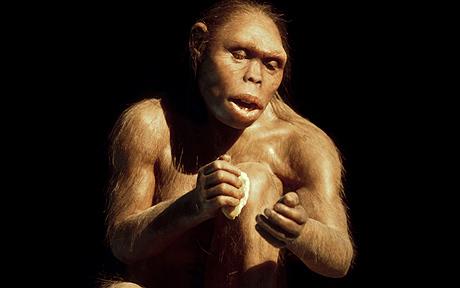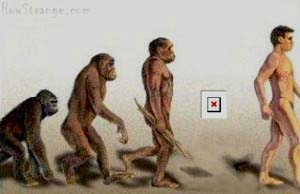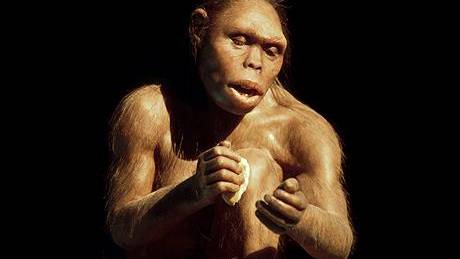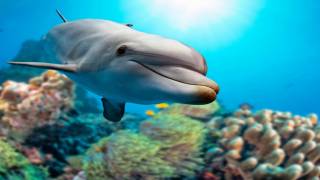"Missing link" between humans and their apelike ancestors to be announced
Source: telegraph.co.uk
The new species of hominid, the evolutionary branch of primates that includes humans, is to be revealed when the two-million-year-old skeleton of a child is unveiled this week.
Homo habilis lived 2.0-1.6 million years ago and had a wide distribution in Africa Photo: SPL
Scientists believe the almost-complete fossilised skeleton belonged to a previously-unknown type of early human ancestor that may have been a intermediate stage as ape-men evolved into the first species of advanced humans, Homo habilis.
Experts who have seen the skeleton say it shares characteristics with Homo habilis, whose emergence 2.5 million years ago is seen as a key stage in the evolution of our species.
The new discovery could help to rewrite the history of human evolution by filling in crucial gaps in the scientific knowledge.
Most fossilised hominid remains are little more than scattered fragments of bone, so the discovery of an almost-complete skeleton will allow scientists to answer key questions about what our early ancestors looked like and when they began walking upright on two legs.
Palaeontologists and human evolutionary experts behind the discovery have remained silent about the exact details of what they have uncovered, but the scientific community is already abuzz with anticipation of the announcement of the find when it is made on Thursday.
The skeleton was found by Professor Lee Berger, from the University of the Witwatersrand, while exploring cave systems in the Sterkfontein region of South Africa, near Johannesburg, an area known as "the Cradle of Humanity".
The find is deemed to be so significant that Jacob Zuma, the South African president, has visited the university to view the fossils and a major media campaign with television documentaries is planned.
Professor Phillip Tobias, an eminent human anatomist and anthropologist at the university who was one of three experts to first identify Homo habilis as a new species of human in 1964, described the latest discovery as "wonderful" and "exciting".
Although not directly involved in the excavation and subsequent research on the fossils, he is one of the select few scientists outside the research group who have been able to see the skeletons.
He said: "To find a skeleton as opposed to a couple of teeth or an arm bone is a rarity.
"It is one thing to find a lower jaw with a couple of teeth, but it is another thing to find the jaw joined onto the skull, and those in turn uniting further down with the spinal column, pelvis and the limb bones.
"It is not a single find, but several specimens representing several individuals. The remains now being brought to light by Dr Berger and his team are wonderful."
The new fossil skeleton was found along with a number of other partially-complete fossils, encased within breccia sedimentary rock inside a limestone cave known as Malapa cave.
The protection from the elements provided by the cave is thought to have played a large part in keeping the fossils so well preserved.
The fossil record of early humans is notoriously patchy and scientists now hope that the that the new remains will provide fresh clues about how our species evolved.
Scientists believe that a group of apelike hominids known as Australopithicus, which first emerged in Africa around 3.9 million years ago, gradually evolved into the first Homo species.
Over time the Australopithicus species lost their more apelike features as they started to stand upright and their brain capacity increased.
Around 2.5 million years ago Homo habilis, the first species to be described as distinctly human, began to appear, although only a handful of specimens have ever been found.
It is thought that the new fossil to be unveiled this week will be identified as a new species that fits somewhere between Australopithicus and Homo habilis.
If it is confirmed as a missing link between the two groups, it would be of immense scientific importance, helping to fill in a gap in the evolutionary history of modern man.
Dr Simon Underdown, an expert on human evolution at Oxford Brookes University, said the new find could help scientists gain a better understanding of our evolutionary tree.
He said: "A find like this could really increase our understanding of our early ancestors at a time when they first started to become recognisable as human."
The discovery is the most important find from Sterkfontein since an almost-complete fossil of a 3.3 million year old Australopithecus, nicknamed Little Foot, was found in 1994.
Another major discovery was the well-preserved skull of a 2.15 million year old Australopithecus africanus, nicknamed Mrs Ples, in 1947.
Finding almost complete fossilised skeletons of human ancestors is particularly prized by the scientific community.
The presence of a pelvis and complete limb bones would allow scientists to unravel the posture and method of walking used by the extinct species.
If the specimen also contains hand bones, it could provide clues about the species’ dexterity and such evidence will prove crucial in determining when the ability of modern humans to handle stone tools first emerged.
Dr Kevin Kuykendall, a palaeoanthropologist at Sheffield University, said such finds were essential in helping to fill in the gaps in our knowledge about human ancestors.
He said: "The information we have right now is probably only based on a few hundred individuals through out the whole world, but some of these are single isolated teeth.
"If this new specimen is more complete and provides better information, all those models about locomotive behaviour will have a chance to really go under scrutiny and refined."
Article from: Telegraph.co.uk

Missing Link
[Ed note: You’d think they’d be careful tossing the term ’missing link’ around after the "Ida" flap]:
’Eighth wonder’ Ida is not related to humans, claim scientists
Why Ida fossil is not the missing link
The palaeontologist who brought fossil Ida to the world
Bone Crunching Debunks ’First Monkey’ Ida Fossil Hype






















